
Establishment and Characterization of a New Human
From www.bloodjournal.org by guest on February 6, 2015. For personal use only. Establishment and Characterization of a New Human Leukemia Cell Line Derived From M,E, By Kohsuke Yanagisawa, Takahiko Horiuchi, and Shigeru Fujita A new human leukemia cell line, designated as ME-1, was established from the peripheral blood leukemia cells of a patient with acute myelomonocytic leukemia with eosinophilia (M,E,). This cell line has the characteristic chromosome abnormality of M,E,, inv(l6) (p13q22).When cultured in RPMI 1640 medium containing 10% fetal calf serum, ME-1 cells were monoblastoid, but with the addition of cytokines such as interleukin-3 (IL-3). granulocyte-macrophage colonystimulatingfactor (GM-CSF), IL-4, or medium conditioned by phytohemagglutinin-stimulated human peripheral leukocytes (PHA-LCM), the cells exhibited differentiationto macrophage-like cells. PHA-LCM also promoted eosinophiliclineage differentiation of this cell line, although IL-5 did not do so. To elucidate the mechanism of proliferation and differentiationof ME-1 cells, we studied the effect of a potent inhibitor of protein kinase C, 1-(5-isoquinolinyl-suIfonyl)-2methylpiperazine (H-7). on colony formation of ME-1 cells. H-7 inhibited colony formation of ME-1 cells by IL-3 or GM-CSF dose dependently, but had little inhibitory effect on colony formation by IL-4. These results indicate that the proliferation and differentiation of ME-1 cells by IL-3 or GM-CSF were related to the activation of protein kinase C, while those by IL-4 involved other regulatory systems. ME-1 cells should be useful for studying the pathogenesis of M,E, and the mechanisms of proliferation and differentiation of leukemic and normal progenitorsby cytokines. 0 1991by The American Society of Hematology. S at 37°C in a humidified atmosphere of 5% CO, in air. The medium was changed two to three times a week. After cell growth was confirmed in the wells, the cells were transferred to 24-well microplates (No. 25820; Coming Glass Works, Corning, NY), and finally, the growing cells were maintained in culture flasks (No. 3013; Falcon). Cytochemical staining. Cells were centrifuged in a Shandon cytospin (Shandon Southern Products Ltd, Cheshire, UK) and stained with May-Griinwald-Giemsa solution, peroxidase, a-naphthy1 butyrate esterase, naphthol AS-D chloroacetate esterase, Luxol-fast-blue, and toluidine blue. Cellsurface markers. Cells were tested by direct immunofluorescence for membrane antigens using various monoclonal antibodies (MoAbs): OKDR, T l 1 (CD2), Leu9 (CD7), J5 (CDlO), B1 (CD20), Mol (CDllb), Mo2 (CD14), MY4 (CD14), MY7 (CD13), and MY9 (CD33). T11, J5, B1, Mol, Mo2, MY4, MY7, and MY9 were purchased from Coulter Immunology (Hialeah, FL), and OKDR and Leu9 were purchased from Becton Dickinson (Oxnard, CA). Epstein-Barr virus nuclear antigen (EBNA). The presence of EBNA was tested by the method of Reedman and Klein.’ Lysozyme and phagocytic activity. Lysozyme activity in the culture medium was assayed according to the lysoplate technique: and the phagocytic activity of ME-1 cells was tested using latex particles. Chromosome analysis. Chromosome analysis was performed on ME-1 cells in the logarithmic growth phase. Cells were treated with 0.075 m o m KC1 hypotonic solution for 30 minutes at 37”C, and fixed by methanol-acetate (311, vol/vol). Chromosomes were banded by the trypsin-Giemsa method.’ Ultrast~cturaleuamation. Cell pellets were fixed in cacodylatebuffered 2.0% glutaraldehyde for 2 hours and postfixed in cacodylate-buffered 1.0% osmium tetroxide for l hour. Specimens were INCE THE FIRST report by Arthur and Bloomfield,’ acute myelomonocytic leukemia with eosinophilia (M,E,) has been known to be characterized by abnormal eosinophils and the chromosome abnormality inv( 16) (p13q22),’., and patients with M,E, have been reported to have a favorable prognosis? No cell line derived from M,E, has been established to date and the characteristics of the leukemic cells of M,E, are not yet well known. We previously reported that the eosinophils of a patient with M,E, arose from leukemic precursors.6 In this article we report the establishment and some properties of a new leukemia cell line, designated as ME-1, from peripheral blood leukemia cells of a patient with M,E,. MATERIALS AND METHODS Case report. A 38-year-old Japanese man was admitted to Ehime University Hospital (Ehime, Japan) because of fever and swelling of the cervical lymph nodes in August 1986. On admission, his peripheralwhite blood cell (WBC) count was 6.6 X 1041kL,with 22.0% myeloblasts, 47.0% monoblasts, 1.5% eosinophils, and 6.0% basophils. His bone marrow was hypercellular with 12.0% myeloblasts, 47.0% monoblasts, 25.0% eosinophils, and 5.0% basophils (Fig IA). Chromosome analysis of the bone marrow cells showed 46 XY, inv(l6) (p13q22). The patient was diagnosed as having M,E, on the basis of these data. Remission induction chemotherapy with the BHAC-DMP regimen resulted in the complete remission. His first relapse occurred in June 1987, but the chemotherapy soon induced another complete remission. In May 1988, he was admitted again because of a second relapse. His peripheral WBC count was 3.3 X 104/kLwith 60.0% blasts, 3.0% eosinophils, and 6.0% basophils. Chromosome analysis of bone marrow cells showed 47 XY, +8, inv(l6) (p13q22), del(17) ( ~ 1 2 ~ 1 3Despite ). receiving chemotherapy, he died of sepsis and bleeding. Cell culture. At the second relapse, mononuclear cells were collected from the patient’s heparinized peripheral blood by density gradient centrifugation using the Ficoll-Conray method. Mononuclear cells were suspended in RPMI 1640 (GIBCO, Grand Island, NY) supplemented with 10% fetal calf serum (FCS; GIBCO) in plastic culture dishes (No. 1008; Falcon, Oxnard, CA) and incubated for 2 hours at 37°C in a humidified atmosphere of 5% CO, in air. Then the nonadherent cells were collected, washed twice with RPMI 1640 containing 5% FCS, and cultured at 1 x 1061mLin 96-well tissue culture plates (No. 3072; Falcon) using RPMI 1640 supplemented with 20% FCS. The cells were cultured Blood, VOI 78, NO 2 (July 15). 1991: ~ ~ 4 5 1 - 4 5 7 From the First Department of Intemal Medicine, School of Medicine, Ehime University, Ehime, Japan. Submitted October 29, 1990; accepted February 28, 1991. Address reprint requests to Kohsuke Yanagisawa, MD, The First Department of Intemal Medicine, School of Medicine, Ehime University, Shigenobu, Ehime 791-02, Japan. The publication costs of this article were defrayed in part by page charge payment. This article must therefore be hereby marked “advertisement” in accordance with 18 U.S.C.section I734 solely to indicate this fact. 0 I991 by The American Society of Hematology. 0006-4971I9117802-01I1$3.0010 45 1 From www.bloodjournal.org by guest on February 6, 2015. For personal use only. 452 YANAGISAWA, HORIUCHI, AND FUJITA .--. . .. D Fig 1. (A) May-Griinwald-Giemsa (MGG)-stainedpreparation of the patient‘s bone marrow cells containing blasts, eosinophils, and basophils (originalmagnification ~ 1 , 0 0 0 )(. 8 )MGG-stained ME-1 cells cultured under standard conditions (originalmagnification ~1,000).(C) MGG-stained ME-1 cells cultured with 10 U/mL of IL-4 for 7 days (original magnification x 1.000). (D) An MGG-stained ME-1 colony stimulated by 10% PHA-LCM. The colony is composed of eosinophils and macrophage-like cells (originalmagnification x 1.0001. sectioned and examined under a Hitachi HU-12A electron microscope (Hitachi, Tokyo, Japan). Effect of cyrokines on ME-I cells in liquid culture. To examine the effect of cytokines on cell differentiation, ME-1 cells were seeded at 4 x lo’ cells/mL in 10 mL RPMl 1640 containing 10% FCS and the following cytokines at optimal concentrations: interleukin-3 (IL-3) (100 U/mL),“’ granulocyte-macrophage colonystimulating factor (GM-CSF) (100 U/mL),” G-CSF (100 U/mL),” IL-4 (10 U/mL),I3 IL-5 (10 U/mL),I4 or medium conditioned by phytohemagglutinin-stimulated human peripheral leukocytes (PHALCM) (l0%).l5 IL-3, GM-CSF, and IL-5 were purchased from Amersham Japan Co (Tokyo, Japan); G-CSF was kindly provided by Chugai Pharmaceutical Co (Tokyo, Japan); and IL-4 was kindly provided by Ono Pharmaceutical Co (Tokyo, Japan). After incubation for 7 days, viable cells were counted by the trypan blue dye exclusion test. For morphologic and cytochemical analysis, cytospin slides were prepared in a Shandon cytospin and stained with May-Griinwald-Giemsa solution and by cytochemical methods. Effect of cytokines on ME-I cells in semisolid culture. ME-1 cells were cultured in semisolid medium with various cytokines. ME-1 cells (1 x 10‘ cells) were cultured with 1 mL of a-medium (Flow Laboratories, McLean, VA) containing 0.8% methylcellulose, 20% FCS, and IL-3, IL-4, GM-CSF, or PHA-LCM. Cells were then plated onto a plastic dish (No. 1008; Falcon). After incubation for 7 days, colonies having more than 20 cells were counted under an inverted microscope. Smears of cells from each colony were prepared by cytospin and stained with May-Griinwald-Giemsa solution. For estimation of the secondary plating efficiency, primary colonies were picked up and washed twice with a-medium. Then 1 x lo’ ME-1 cells were replated in 1 mL of a-medium containing 0.8% methylcellulose, 20% FCS, and IL-3 or GM-CSF. After incubation for 7 days, colonies having more than 20 cells were counted. Effect of protein kinase C inhibitor on ME-I cells. H-7 (Seikagaku Kogyo, Tokyo, Japan)” was used as the protein kinase C inhibitor. Various concentrations of H-7 were added in the culture medium, and the effects on colony formation of ME-1 cells and their protein kinase C activity were evaluated. Protein kinase C acrivily assay of ME-I cells. Protein kinase C from a cytosolic preparation of ME-1 cells was partially purified using a diethylamino ethanol (DEAE)-cellulose column. The protein kinase C activity was measured by the incorporation of ”P from y-’2P-adenosine triphosphate (y--”P-ATP) into histone H-1 (Sigma Chemical Co, St Louis, MO), as described by Kikkawa et al.” The reaction mixture was a final volume of 250 WLconsistingof 80 p g h L phosphatidylserine, 20 mmol/L Tris, 0.1 mmol/L CaCIZ,5 mmol/L MgCI,, 2.5 nmol y-”P-ATP, 50 p,g of histone H-1.1 ng/mL 12-0-tetradecanoylphorbol-13-acetate (TPA), and 50 WLenzyme preparation. After incubation for 3 minutes at 30°C. the reaction was stopped by the addition of 25% trichloroacetic acid. The acid-precipitable material was collected on Millipore filters (Massachusetts) and counted in a liquid scintillation spectrometer. From www.bloodjournal.org by guest on February 6, 2015. For personal use only. HUMAN LEUKEMIA CELL LINE DERIVED FROM M,E, 453 Table 1. Characteristics of ME-1Cells negative for a-naphthyl butyrate esterase. The cells contained granules positive for Luxol-fast-blue and toluidine blue (Table 1). Cellsurfacemarkzrs. The reactions to the MoAbs showed ME-1 cells had surface antigens specificfor the myelomonocytic lineage: MY4, MY7, MY9, and OKDR (Table 1). Almost all of the cells showed no reaction to J5, B1, T11, or Leu9. EB virus-associated nuclear antigen was not detected in ME-1 cells. Lysozyme activity and phagocytosis. Lysozyme activity of 6.1 bg/mL was detected in the supernatant obtained from a 7-day culture of ME-1 cells when 1 x lo5 cells/mL were seeded. Five percent to 10% of ME-1 cells had phagocytic activity, defined as cells ingesting more than five latex particles. Chromosome anabsis. Chromosome analysis was performed on more than 100 metaphases of ME-1 cells. All of them showed the same chromosome abnormality: 47 X Y , +8, inv(l6) (p13q22), del(17) (p12p13) (Fig 2). This was identical to that of the patient's bone marrow cells at the second relapse. Response to cytokines in liquid culture condition. When ME-1 cells were cultured with IL-3, IL-4, GM-CSF, or PHA-LCM, the cells were induced to differentiate (Table 2). The cells adhered to culture flasks, formed clusters, and showed an increase in size. May-Griinwald-Giemsa-stained cytospin preparations demonstrated that ME-1 cells had differentiated into macrophage-like cells. They showed a significant decrease in the nuclear-cytoplasmic ratio, and an increase in cytoplasmic vacuoles (Fig IC). The a-naphthyl butyrate esterase reaction became positive in macrophagelike cells, whereas peroxidase.reactions became negative in these cells. Differentiation of ME-1 cells into macrophagelike cells was most marked in cultures containing PHALCM (Table 2). Surface marker analysis showed that the expression of some surface antigens for the monocytemacrophage lineage was increased by PHA-LCM. The percentage of cells reactive with the MoAbs OKDR and MY7 increased markedly after treatment with PHA-LCM (Table 3). PHA-LCM also induced ME-1 cells to differen- Growth pattern: Suspension Doubling time: 4-5 days Morphology: Monoblastoid Chromosome analysis: 47 XY, +8, inv(16)(p13q22),de1(17)(p12p13) Cytochemical staining Peroxidase: 80.4% a-Naphthyl-butyrateesterase: 1.6% Naphthol AS-D chioroacetateesterase: 10.6% Luxol-fast-blue: 1.2% Toluidine blue: 0.6% EB virus-associated nuclear antigen (-) Surface marker J5 (CD10) 3.0% MY4 (CD14) 12.8% E1 (CD20) 1.4% MY7 (CD13) 17.9% Leu 9 ( 0 7 ) 0.8% MY9 (CD33) 36.3% Mol (CDllb) 6.2% OKT 11 (CD2) 0.9% OKDR 13.9% Mo2 (CD14) 7.5% Lysozymeproduction: 6.1 pg/mL (supernatantobtained from a 7-day culture when 1 x lO'cells/mL were seeded) RESULTS Establishment of cell line. About 6 months after the culture of the mononuclear cells from the patient's peripheral blood was initiated, gradual proliferation of the cells was observed. Cells were subsequently maintained in continuous culture for 18 months. They grew in suspension with a little adhesion and aggregation and were designated as ME-1 cells. The ME-1 cell line has since been maintained in RPMI 1640 supplemented with 10% FCS and has a doubling time of 4 to 5 days. Morphologic and cytochemical characteristics of the cell line. In May-Griinwald-Giemsa-stained preparations, ME-1 cells were almost all monoblastoid, with a small percentage of the cells being eosinophils, basophils, or macrophage-like cells. The blasts had round or lobulated nuclei with fine chromatin and one to three nucleoli and slightly basophilic cytoplasm with a few vacuoles (Fig 1B). The blasts were significantly positive for peroxidase, weakly positive for naphthol-AS-D chloroacetate esterase, and 1 2 7 6 13 Fig2. G-bsndingkaryotypeof ME-1 cells: 47 XY, +8, inv(l6) (p13q22). del(17) ( ~ 1 2 ~ 1 3 ) . k 19 14 4 3 8 15 t 9 10 t 16 5 11 t 17 12 18 # 20 21 22 X Y From www.bloodjournal.org by guest on February 6, 2015. For personal use only. 454 YANAGISAWA, HORIUCHI, AND FUJITA Table 2. Differentiation of ME-1 Cells by Cytokines (cytochemical analysis) Table 4. Colony Formation of ME-1 Cells by Cytokines Cytokine Percentage of Positive Cells Cell Density After 7 Days ( x lo5 cellslml) Peroxidase Cytokine (-1 PHA-LCM IL-3 GM-CSF G-CSF IL-4 IL-5 9.1 f 0.7 5.8 ? 1.7 10.9 f 1.1 12.2 f 2.5 8.9 f 1.0 6.8 f 0.2 8.9 f 0.1 80.2 9.2 73.8 50.4 83.6 28.0 79.6 (-1 u-Naphthyl- Butyrate Esterase LuxolToluidine Fast-Blue Blue 1.8 74.4 25.8 36.2 7.6 53.4 3.0 1.2 7.4 0.6 0.8 0.8 0.8 1.0 <0.5 <0.5 <0.5 <0.5 <0.5 <0.5 <0.5 For induction of cell differentiation, ME-1 cells were seeded at an initial concentration of 4 x l o 5 cellsimL with or without cytokines. The percentage of positive cells was determined by counting 500 cells. tiate into eosinophils. The percentage of eosinophils positive for Luxol-fast-blue increased from 1.8% to 7.4% in cultures with PHA-LCM. Neither G-CSF nor IL-5 induced ME-1 cells to differentiate, and no combination of the cytokines induced ME-1 cells to differentiate into eosinophils except PHA-LCM. Response to cytokines in semisolid culture condition. In semisolid culture conditions, ME-1 cells formed few colonies without cytokines, but they formed substantial numbers of colonies by the addition of IL-3, IL-4, GM-CSF, or PHA-LCM (Table 4). Colonies formed by IL-4 or PHALCM contained less than 40 cells and colonies formed by IL-3 or GM-CSF contained more than 50 to 100 cells. Morphologic analysis of 100 colonies formed in the presence of PHA-LCM by May-Griinwald-Giemsa staining showed 84 macrophage-like cell colonies, 14 macrophagelike cell-eosinophil colonies (Fig lD), 1 macrophage-like cell-basophil colony, and 1macrophage-like cell-eosinophilbasophil colony. Colonies formed by IL-4 consisted almost entirely of macrophage-like cells, and colonies formed by IL-3 or GM-CSF consisted of blasts and macrophage-like cells. Secondary plating efficiency was estimated for cells from colonies formed by IL-3 or GM-CSF. Cells from colonies formed by IL-4 had a very low plating efficiency (Table 5). Colony-stimulating activity was not found in the supernatant of ME-l cells (data not shown). By Northern blot analysis, no messages for GM-CSF or G-CSF were found in ME-1 cells (data not shown). Electron microscopy findings. Electron microscopy showed that ME-1 cells had clear large nuclei with welldefined nucleoli and a few mitochondria, rough endoplasmic reticula, and Golgi apparatuses in the cytoplasm (Fig 3A). On the other hand, almost all the differentiated ME-1 cells induced by PHA-LCM showed a significant decrease Table 3. Differentiation of ME-1 Cells by PHA-LCM (surface marker analysis) Colony Size (cells) 4 f 1 268 ? 78 140 f 17 115 f 27 22f 13 57 f 14 5 40 5 40 250 100 250 100 5 40 5 40 in the nuclear-cytoplasmic ratio and had many cytoplasmic components (Fig 3B). Phagocytosis was sometimes seen in some of these differentiated cells. Other differentiated cells had many granules in the cytoplasm. The granules were large and spherical, and appeared as membrane-limited vacuoles partially filled with electron-dense material. The granules had similar morphologic characteristics to those of normal immature eosinophils, but they lacked the central crystalloids (Fig 3C and D), which are characteristic of normal eosinophils. Effect of the protein kinase C inhibitor H-7 on colony formation of ME-1 cells. The effect of the protein kinase C inhibitor H-7 on colony formation of ME-1 cells by IL-3, IL-4, or GM-CSF was examined (Fig 4). H-7 inhibited the colony formation by IL-3 or GM-CSF dose dependently, while it showed little effect on colony formation by IL-4. Effect of H-7 on the protein kinase C activity of ME-1 cells. To determine whether the inhibitory effect on colony formation of ME-1 cells by H-7 was related to protein kinase C activity, we examined the effect of H-7 on the protein kinase C activity of ME-1 cells. As shown in Fig 5, H-7 inhibited the protein kinase C activity of ME-1 cells dose dependently. This dose-dependent decrease in protein kinase C activity corresponded to the effect of H-7 on colony formation of ME-1 cells by IL-3 or GM-CSF. DISCUSSION In the present study, the ME-1 cell line derived from the peripheral blood leukemia cells of a patient with acute myelomonocytic leukemia with eosinophila (M,E,) has been established. Cytogenetic analysis of the ME-1 cells showed a karyotype of 47 XY, +8, inv(l6) (p13q22), del(17) (p12p13), which was identical to that of the patient's bone marrow cells and demonstrated that this cell line originated from the patient's leukemic blasts. Most of ME-1 cells had a blastic appearance, but a small percentage of the cells were macrophage-like cells, eosinophils, or basophils. IL-3, GMTable 5. Secondary Colony Formation of ME-1 Cells Primary Colony Stimulator Secondary OKDR MY7 MY9 Mol 18.4 79.5 26.0 67.5 16.3 35.6 10.0 5.2 - 'Values are the means f SD to triplicate cultures. Colony Stimulator Percentage of Positive Cells ME-1 cells PHA-LCM-stimulated ME-1 cells (7 d) PHA-LCM IL-3 GM-CSF G-CSF IL-4 No. of Colonies" (per i o 5 cells) IL-3 GM-CSF IL-3 GM-CSF IL-4 1 1 6 ? 11 56 ? 39 53 f 11 4424 3?2 0 Values represent the secondary colony numbers per l o 5 cells from colonies formed by each primary colony stimulator. Colony numbers are the means ? SD to triplicate cultures. From www.bloodjournal.org by guest on February 6, 2015. For personal use only. HUMAN LEUKEMIA CELL LINE DERIVED FROM M,E, 455 Fig 3. (A) Ultrastructuralappearance of an ME-1 cell cultured under standard conditions (original magnification ~6,000).(E) Ultrastructural appearance of a macrophage-like ME-1 cell cultured with 10% PHA-LCMfor 7 days (original magnification~4,000).(C) Ultrastructuralappearance of an ME-1 cell with granules cultured with 10%PHA-LCM for 7 days (originalmagnification ~ 6 , 0 0 0 )(D) . Higher magnification of granules in an ME-1 cell cultured in 10%PHA-LCM for 7 days (originalmagnification ~ 1 5 , 0 0 0 ) . CSF, IL-4, or PHA-LCM, which contains many cytokines, induced the differentiation of ME-1 cells. They mainly induced differentiation into macrophage-like cells. PHALCM also induced differentiation to eosinophils, but IL-5, which has been reported to induce eosinophilic differentiadon,'4 did not do so in this cell line. IL-3 and GM-CSF are known to stimulate monocytic precursors and induce differentiation to monocyte-macr~phage,".'~ and the ability of IL-4 was recently reported to transform monocytes into macrophages." ME-1 cells exhibited responsiveness to those cytokines and differentiated into macrophage-like cells as do normal macrophage precursors. In this respect, the ME-1 cell line appears to be valuable as a model cell line to study the mechanism of cell differentiation by cytokines, because myeloid leukemia cell lines such as HL-60 and U937 have little or no differentiation response to these cytokines?' IL-5,IL-3, and GM-CSF have been reported to induce eosinophilic differentiati~n,'~.''.'~but all of these cytokines had no effect of eosinophilic differentiation on ME-l. PHA-LCM induced a small number of ME-l blasts to differentiate into eosinophils, but PHA-LCM induced most of the ME-1 cells to macrophage-like cells. PHA-LCM contains IL-3, GM-CSF, and other cytokines,u and it has been reported to have an "eosinophil-stimulating a~tivity."~.*~ In the present study, it can be suggested that the differentiation of ME-1 cells into eosinophils was related to this eosinophil-stimulatingactivity, which was not IL-5, IL-3, or GM-CSF. Ultrastructural examination of From www.bloodjournal.org by guest on February 6, 2015. For personal use only. 456 YANAGISAWA, HORIUCHI, AND FUJITA 100 % 60 x v .-12 40 C 0 5 20 0 U M I L - 3 , H-7 HGM-CSF, H-7 W I L - 4 , H-7 I! 5 10 Concentration of H - 7 ( y M) 1 Fig 4. Effect of H-7 on colony formation of ME-1 cells in response to IL-3, IL-4, or GM-CSF. Results are given as the percentage of the number of colonies in each control culture. PHA-LCM-stimulated cells showed the existence of “abnormal eosinophils” with granules containing electron-dense material and lacking central crystalloids. These characteristics of eosinophils have also been reported in other patients with M4E0.2.4In semisolid culture, ME-1 cells formed colonies in response to IL-3, IL-4, GM-CSF, or PHA-LCM. Colonies formed by PHA-LCM contained various combinations of macrophage-like cells, eosinophils, and basophils. These results demonstrated that clonogenic ME-1 cells with inv( 16) were able to differentiate to macrophage-like cells, eosinophils, and basophils. It has been shown that patients with M4E, had an inversion of chromosome 16,’-’ and some cases of M,E, with basophilia have been reported recently.””6 Thus, the eosinophils and basophils in M,E, Concentration of H - 7 ( p M) Fig 5. Effect of H-7 on the protein kinase C activity of ME-1 cells. Results are given as the percentage of control assays in the presence of TPA, CaCI,, and phosphatidylserine. Protein kinase C activity is expressed as picomoles of incorporated into histone H-l/min/lQ cells. The activity was 31.0 pmol and 0.4 pmol ”P in the presence and absence of TPA, CaCI, and phosphatidylserine,respectively. patients appear to be part of the neoplastic process, but no direct evidence for this hypothesis had been obtained. In a previous report, we have recently demonstrated the neoplastic involvement of monocytic, eosinophilic, and basophilic lineages in the patient with M,E, from whose leukemic cells the ME-1 cell line was established, by a cytogenetic, cytochemical, and morphologic analysis of colonies derived from leukemic precursors.6 The data we obtained for the ME-1 cell line also confirm that eosinopils and basophils in M,E, are neoplastic cells. CSFs stimulate the proliferation and differentiation of hematopoietic precursors. CSFs also act to promote the differentiation and self-renewal of the leukemic progenitors of acute myeloblastic leukemia (AML) blast In the ME-1 cell line, IL-3 or GM-CSF promoted differentiation from blasts to mature macrophage-like cells, but they also stimulated self-renewal of clonogenic ME-1 cells, as shown by the secondary plating efficiency study. On the other hand, IL-4, which was first named B-cell-stimulating factor-1, induced ME-1 cells to macrophage-like cells and the cells from colonies formed by IL-4 had very low secondary plating efficiency. Thus, it was concluded that IL-4 induced the differentiation of ME-1 cells without stimulating their self-renewal capacity. These results suggest the possibility that IL-4 may become a useful therapeutic agent for AML. Protein kinase C appears to have an important role in the signal transduction responses in various cell^.'^,^' For hematopoietic cells, using a hematopoietic growth factordependent cell line and human myeloid progenitor cells, it has also been suggested that activation of protein kinase C was involved in the proliferation of progenitor cells stimulated by CSFS.~’.~~ We examined the effect of the protein kinase C inhibitor H-7 on the stimulation of colony formation of ME-l cells by IL-3, GM-CSF, or IL-4. Colony formation of ME-1 cells by IL-3 or GM-CSF was inhibited by H-7 dose dependently. In contrast, colony formation by IL-4 was affected little, suggesting that the inhibitory effect of H-7 was not due to cytotoxicity. In addition, H-7 inhibited the protein kinase C activity of ME-1 cells dose dependently in a manner corresponding to its effect of H-7 on the response of ME-1 cells to IL-3 or GM-CSF. These results indicate that the proliferation and differentiation of ME-1 cells by IL-3 or GM-CSF were related to the activation of protein kinase C, whereas those by IL-4 involved other regulatory systems. Recent indicating that IL-4 did not induce protein kinase C translocation from cytosol to membrane in resting murine B lymphocytes support our results. ME-1 is a unique leukemia cell line derived from M,E, that responds to CSFs and IL-4. ME-1 can provide a useful model for studying the pathogenesis of M,E, and the mechanisms of proliferation and differentiation of leukemic and normal progenitors by cytokines. ACKNOWLEDGMENT The authors express their great appreciation to Prof Yuzuru Kobayashi for his continuous support of this work and the valuable comments. From www.bloodjournal.org by guest on February 6, 2015. For personal use only. 457 HUMAN LEUKEMIA CELL LINE DERIVED FROM M,E, REFERENCES 1. Arthur DC, Bloomfield CD: Partial deletion of the long arm of chromosome 16 and bone marrow eosinophilia in acute nonlymphocytic leukemia: A new association. Blood 61:994, 1983 2. Le Beau MM, Larson RA, Bitter MA, Vardiman JW, Golomb HM, Rowley JD: Association of an inversion of chromosome 16 with abnormal marrow eosinophils in acute myelomonocytic leukemia: A unique cytogenetic-clinicopathological association. N Engl J Med 309:630,1983 3. Tantravahi R, Schwenn M, Henkle C, Ne11 M, Leavitt PR, GriffinJD, Weinstein HJ: A pericentric inversion of chromosome 16 is associated with dysplastic marrow eosinophils in acute myelomonocytic leukemia. Blood 63300,1984 4. Bitter MA, Le Beau MM, Larson RA, Rosner MC, Golomb HM, Rowley ID, Vardiman JW: A morphologic and cytochemical study of acute myelomonocytic leukemia with abnormal marrow eosinophils associated with inv(l6) (p13q22). Am J Clin Pathol 81:733,1984 5. Larson RA, Williams SF, Le Beau MM, Bitter MA, Vardiman JW, Rowley JD: Acute myelomonocytic leukemia with abnormal eosinophils and inv(l6) or t(16;16) has a favorable prognosis. Blood 68:1242,1986 6. Yanagisawa K, Fukuoka T, Fujita S: Evidence for the neoplastic involvement of monocytic, eosinophilic and basophilic lineages in acute myelomonocytic leukemia with eosinophilia. Acta Haemato1 83:145,1990 7. Reedman BM, Klein G: Cellular localization of an EpsteinBarr virus (EBV)-associated complement-fixing antigen in producer and nonproducer lymphoblastoid cell lines. Int J Cancer 11:499,1973 8. Osserman EF, Lawlor DP: Serum and urinary lysozyme (muramidase) in monocytic and monomyelocytic leukemia. J Exp Med 124:921,1966 9. Seabright M: A rapid banding technique for human chromosomes. Lancet 2:971,1971 10. Yang Y-C, Ciarletta AB,Temple PA, Chung MP, Kovacic S, Witek-Giannotti JS, Leary AC, Kriz R, Donahue RE, Wong GG, Clark SC: Human IL-3 (Multi-CSF): Identification by expression cloning of a novel hematopoietic growth factor related to murine IL-3. Cell 47:3,1986 11. Burgess AW, Begley CG, Johnson GR, Lopez AF, Williamson DJ, Mermod JJ, Simpson RJ, Schmitz A, DeLamarter J F Purification and properties of bacterially synthesized human granulocyte-macrophage colony stimulating factor. Blood 69:43,1987 12. Nagata S, Tsuchiya M, Asano S, Kaziro Y, Yamazaki T, Yamamoto 0, Hirata Y, Kubota N, Oheda M, Nomura H, Ono M: Molecular cloning and expression of cDNA for human granulocyte colony-stimulating factor. Nature 319:415, 1986 13. Yokota T, Otsuka T, Mosmann T, Banchereau J, De France T, Blanchard D, De Vries JE, Lee F, Arai K Isolation and characterization of human interleukin cDNA clone, homologous to mouse B-cell stimulating factor 1, that expresses B-cell and T-cell stimulating activities. Proc Natl Acad Sci USA 835894, 1986 14. Campbell HD, Tucker WQJ, Hort Y, Martinson ME, Mayo G, Clutterbuck EJ, Sanderson CJ,Young IG: Molecular cloning, nucleotide sequence, and expression of the gene encoding human eosinophil differentiation factor (interleukin 5). Proc Natl Acad Sci USA 84:6629,1987 15. Aye MT, Till JE, McCulloch E A Interacting populations affecting proliferation of leukemic cells in culture. Blood 45:485, 1975 16. Hidaka H, Inagaki M, Kawamoto S, Sasaki Y: Isoquinolinesulfonamides, novel and potent inhibitors of cyclic nucleotide dependent protein kinase and protein kinase C. Biochemistry 235036,1984 17. Kikkawa U, Takai Y, Minakuchi R, Inohara S, Nishizuka Y: Calcium-activated, phospholipid-dependent protein kinase from rat brain. J Biol Chem 257:13341, 1982 18. Messner HA, Yamasaki K, Jamal N, Minden MM, Yang Y-C, Wong GG, Clark S C Growth of human hemopoietic colonies in response to recombinant gibbon interleukin 3: Comparison with human recombinant granulocyte and granulocyte-macrophage colony-stimulating factor. Proc Natl Acad Sci USA 84:6765,1987 19. Metcalf D, Begley CG, Johnson GR, Nicola NA, Vadas MA, Lopez AF, Williamson DJ, Wong GG, Clark SC, Wang E A Biologic properties in vitro of a recombinant human granulocytemacrophage colony-stimulating factor. Blood 67:37,1986 20. Te Velde A, Klomp J, Yard B, De Vries JE, Figdor CG: Modulation of phenotypic and functional properties of human peripheral blood monocytes by IL-4. J Immunol140:1548,1988 21. Maekawa T, Metcalf D: Clonal suppression of HL-60 and U937 cells by recombinant human leukemia inhibitory factor in combination with GM-CSF or G-CSF. Leukemia 3:270,1989 22. Fauser AA, Messner HA: Granuloerythropoietic colonies in human bone marrow, peripheral blood, and cord blood. Blood 52:1243,1978 23. Cline MJ, Golde D W Production of colony stimulating activity by human lymphocytes. Nature 248:703,1974 24. Horie S, Sugimoto M, Wakabayashi Y: In vitro growth of eosinophil colonies from normal human peripheral blood. Acta Haematol Jpn 52:608,1989 25. Matsuura Y, Sato N, Kimura F, Shimomura S, Yamamoto K, Enomoto Y, Takatani 0:An increase in basophils in a case of acute myeolomonocytic leukaemia associated with marrow eosinophilia and inversion of chromosome 16. Eur J Haematol39:457,1987 26. Abe Y, Umeda M, Kosuge T, Arai N, Shirai T: A case of acute eosinophilo-myelomonocyticleukemia with peripheral basophilia. Jpn J Clin Hematol29:44,1988 27. Hoang T, Nara N, Wong G, Clark S, Minden MD, McCulloch E A The effects of recombinant GM-CSF on the blast cells of acute myeloblastic leukemia. Blood 68:313, 1986 28. Griffin JD, Young D, Herrmann F, Wiper D, Wagner K, Sabbath KD: Effects of recombinant human GM-CSF on proliferation of clonogenic cells in acute myeloblastic leukemia. Blood 67:1448,1986 29. Delwel R, Dorssers L, Touw I, Wagemaker G, Lowenberg B: Human recombinant multilineage colony stimulating factor (interleukin-3): Stimulator of acute myelocytic leukemia progenitor cells in vitro. Blood 70:333, 1987 30. Nishizuka Y: The role of protein kinase C in cell surface signal transduction and tumor promotion. Nature 308:693,1984 31. Nishizuka Y: Studies and perspectives of protein kinase C. Science 233:305, 1986 32. Farrar WL, Thomas TP, Anderson WB: Altered cytosol/ membrane enzyme redistribution on interleukin-3 activation of protein kinase C. Nature 315:235,1985 33. Katayama N, Nishikawa M, Minami N, Shirakawa S: Putative involvement of protein kinase C in proliferation of human myeloid progenitor cells. Blood 73:123, 1989 34. Justement L, Chen Z, Harris L, Ransom J, Sandoval V, Smith C, Rennick D, Roehm N, Cambier J: BSF 1 induces membrane protein phosphorylation but not phosphoinositide metabolism, Ca2+ mobilization, protein kinase C translocation, or membrane depolarization in resting murine B lymphocytes. J Immunol137:3664,1986 35. Paul WE, Mizuguchi J, Brown M, Nakanishi K, Hornbeck P, Rabin E, Ohara J: Regulation of B-lymphocyte activation, proliferation, and immunoglobulin secretion. Cell Immunol99:7, 1986 From www.bloodjournal.org by guest on February 6, 2015. For personal use only. 1991 78: 451-457 Establishment and characterization of a new human leukemia cell line derived from M4E0 K Yanagisawa, T Horiuchi and S Fujita Updated information and services can be found at: http://www.bloodjournal.org/content/78/2/451.full.html Articles on similar topics can be found in the following Blood collections Information about reproducing this article in parts or in its entirety may be found online at: http://www.bloodjournal.org/site/misc/rights.xhtml#repub_requests Information about ordering reprints may be found online at: http://www.bloodjournal.org/site/misc/rights.xhtml#reprints Information about subscriptions and ASH membership may be found online at: http://www.bloodjournal.org/site/subscriptions/index.xhtml Blood (print ISSN 0006-4971, online ISSN 1528-0020), is published weekly by the American Society of Hematology, 2021 L St, NW, Suite 900, Washington DC 20036. Copyright 2011 by The American Society of Hematology; all rights reserved.
© Copyright 2025
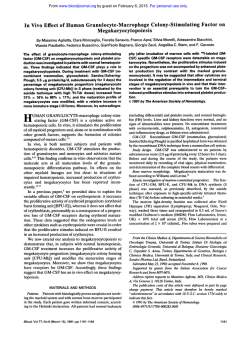
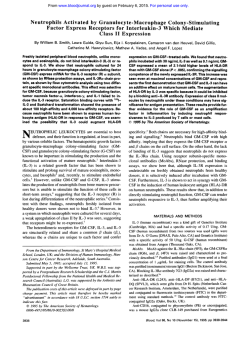
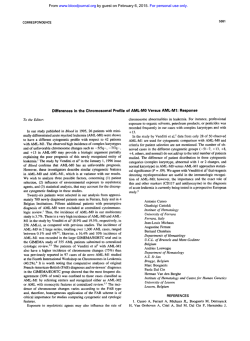
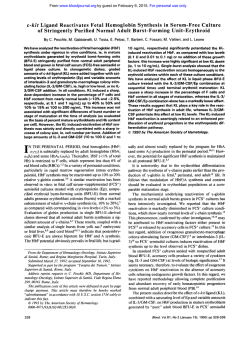
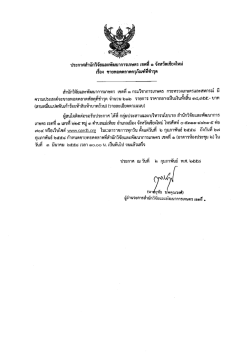
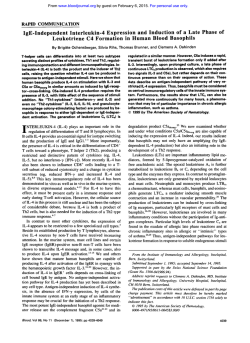
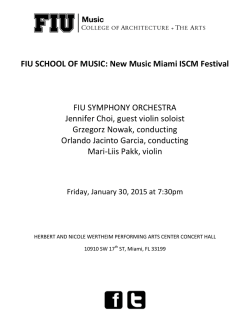
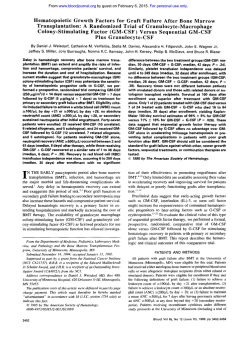
![Download [ PDF ] - journal of evolution of medical and dental sciences](http://s2.esdocs.com/store/data/000478000_1-0e764d17efdf7e0f7a1db4e485c2c1ed-250x500.png)